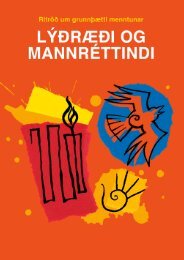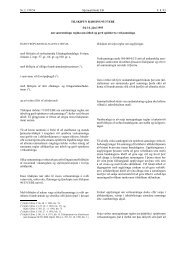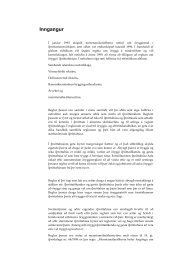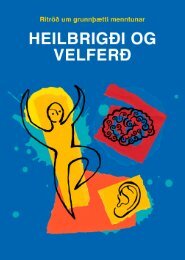Arts and Cultural Education in Iceland : Professor Anne Bamford
Arts and Cultural Education in Iceland : Professor Anne Bamford
Arts and Cultural Education in Iceland : Professor Anne Bamford
You also want an ePaper? Increase the reach of your titles
YUMPU automatically turns print PDFs into web optimized ePapers that Google loves.
quantitative data. A total of 551 surveys were distributed with an average response rate of<br />
76.3%.<br />
The field research was conducted <strong>in</strong> 11 municipalities <strong>in</strong> Icel<strong>and</strong> <strong>and</strong> through a matrix it was<br />
ensured that a diversity of types of schools <strong>and</strong> <strong>in</strong>stitutions were covered as part of the data<br />
collection.<br />
The research used a range of methodologies <strong>in</strong>clud<strong>in</strong>g:<br />
Document <strong>and</strong> media analysis<br />
Internet-based survey for quantitative data<br />
Interviews<br />
Focus groups<br />
Observations<br />
Provisions for electronic submissions by email<br />
The scope of the study <strong>in</strong>cluded a comprehensive sample of formal school provisions for<br />
young people between the ages of 1-20+ years <strong>and</strong> also <strong>in</strong>corporated non-formal cultural<br />
offer<strong>in</strong>gs that directly <strong>in</strong>tersected with the specified target group.<br />
A survey was sent to all pre-schools (n=255); all compulsory schools (n=170); all upper<br />
secondary schools (n=30); art <strong>and</strong> dance schools (n=18) <strong>and</strong> music schools (n=88). The response<br />
rates were as follows: 53.7% of pre-schools completed the survey; 78.8% of compulsory schools<br />
completed the survey; 96.7% of upper secondary schools completed the survey; 72.2% of art<br />
<strong>and</strong> dance schools completed the survey; <strong>and</strong> 85% of music schools completed the survey.<br />
A detailed evidence-based analysis of arts <strong>and</strong> cultural education resulted <strong>in</strong> the production<br />
of this published report, an executive summary, <strong>and</strong> <strong>in</strong>itiated public <strong>and</strong> media discussions.<br />
The appo<strong>in</strong>tment of an <strong>in</strong>-country researcher to work as a collaborative member of the<br />
research team for the duration of the project ensured that – while the study could be conducted<br />
<strong>in</strong> an <strong>in</strong>dependent <strong>and</strong> unbiased manner – the methodology <strong>and</strong> analysis could benefit from the<br />
value of local contextual underst<strong>and</strong><strong>in</strong>g. The <strong>in</strong>-country researcher was responsible for<br />
translations <strong>and</strong> ensured that contextual knowledge <strong>and</strong> <strong>in</strong>terpretations were embedded <strong>in</strong> the<br />
project. This person also sought relevant ‘on the ground’ permissions <strong>and</strong> selected, planned <strong>and</strong><br />
booked meet<strong>in</strong>gs, agendas, it<strong>in</strong>eraries, accommodation <strong>and</strong> visits, <strong>in</strong>-l<strong>in</strong>e with agreed the<br />
research plan.<br />
All participants were given full <strong>and</strong> open access to the <strong>in</strong>formation ga<strong>in</strong>ed <strong>and</strong> <strong>in</strong>vited to<br />
comment <strong>and</strong> respond to the report. All data rema<strong>in</strong>s protected as per <strong>in</strong>ternational data<br />
protection protocols. The contributors were acknowledged <strong>and</strong> referenced <strong>in</strong> the work where<br />
this did not contravene privacy. The aim was to highlight salient, transferable <strong>and</strong> overarch<strong>in</strong>g<br />
themes, not to comment on the success or otherwise of particular cases or specific schools,<br />
<strong>in</strong>dividuals, groups or organisations. As far as possible, actual quotations have been used to<br />
evidence the analysis made. These extended narratives allow for an authentic <strong>in</strong>sight <strong>in</strong>to all<br />
levels of the implementation <strong>and</strong> delivery cycle <strong>and</strong> present a cross section of the views of<br />
stakeholders. Where contradictions of evidence occur, these embedded anomalies are<br />
highlighted <strong>and</strong> the range of op<strong>in</strong>ion fully represented.<br />
Each section beg<strong>in</strong>s with a summary of the key f<strong>in</strong>d<strong>in</strong>gs of that particular topic, theme or<br />
issue. When read<strong>in</strong>g the report, where po<strong>in</strong>ts are particularly pert<strong>in</strong>ent to particular levels or<br />
types of schools or <strong>in</strong>stitutions, these have been specified <strong>and</strong> it is clearly <strong>in</strong>dicated the level or<br />
12



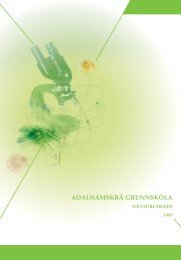
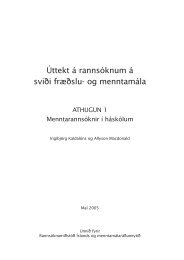

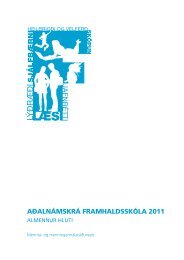
![Aðalnámskrá tónlistarskóla : rytmÃsk tónlist [Eingöngu á rafrænu formi]](https://img.yumpu.com/50843672/1/184x260/aaalnamskra-tanlistarskala-rytma-sk-tanlist-eingangu-a-rafranu-formi.jpg?quality=85)
